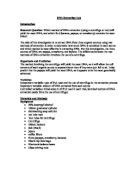Furthermore, there became a development of teams that were interested in being the first to determine the structure of the DNA molecule. A research scientist named Linus Pauling suggested that it was a three chained helix, hitherto he never really did much research with DNA since he was already deeply concentrated in other areas of research. However, at this time he had a successful background in helical proteins.
Moreover, a new member joined Maurice Wilkins at King’s College in 1951, named Rosalind Franklin. Franklin’s tasks was to clean off dusty files and equipment in order to maintain the technique of the x-ray photographing a DNA molecule. With so many individuals working with DNA within Europe, Watson and Crick also began to indulged in this DNA molecule paradox.
Unfortunately, for a while the structure of the DNA molecule was not clear. Many presumed that if it was a helix, how many strands was it composed of? Rosalind Franklin produced several, remarkable x-ray photographs, nonetheless even she did not realize how her photographs showed that DNA was a double helix. It took the initiative of the Watson-Crick team to make this evident.
Before Crick saw the x-ray photographs, he heard about them from Watson. Watson attended a seminar where Rosalind Franklin presented her discoveries. She disclosed her photographs to the seminar attendees, and pronounced other aspects of her DNA research. Watson returned to Crick’s without any notes from the seminar. Watson depended on his memory, but it was ultimately a failure because he was only able to convey to his partner qualitative descriptions rather then exact quantitative descriptions. It was implied that if Crick attended the seminar, or if Watson took notes, they might have solved the puzzle sooner.
The fact that Crick was experienced with x-ray diffraction by helical proteins made it less difficult for him to decode the information in the x-ray photograph of a DNA molecule. He was able to make mathematical calculations about bond angles and distance between atoms. Yet his initial calculations were off, even if only slightly. Unfortunately, he and Watson were asked by their cooperating supervisor to dismiss their DNA workings and immediately return to the work he had intended for them. They continued their work for their supervisor for approximately a year.
Meanwhile, in the year 1952, it seemed as though Rosalind Franklin was the only person working on DNA assiduously. It was during this period that she produced additional photographs; yet she was not ready to put forth conviction in the idea of a helix. She kept comprehensive lab notes, and she noted to herself frequently that she did think that there was a possibility that it could be a helix, or a double helix, yet she was vigilant and conservative and kept these contemplations between herself and her lab book. Contrary to her thoughts, in public she scrutinized the notion of it being a double helix. Some colleagues and spectators of her time deemed her inexperienced and not knowledgeable enough to examine and pull any data about a structure from the x-ray crystallography photographs.
Maurice Wilkins initially gave Rosalind Franklin the permission to put all her efforts into DNA. When he requested that she share her findings, she denied his request for she was under the impression that it was her individual work and no one else’s. This misunderstanding became a source of tension and antagonism between Franklin and Wilkins. This hostility did not stop her research. She and her research assistant worked persistently, perfecting the technique of isolating single fibers for x-ray crystallography and in doing that it resulted in her production of over 50 photograph depictions of DNA. While Franklin was constantly producing images of DNA, the images produced two different forms of DNA subsequently; she remained hesitant to adapt the assumption that DNA was a double helix.
Eventually Watson and Crick recommenced their pursuit and rejoined the race. Yet, this time Crick saw the photographs taken by Franklin first-hand. Within weeks they were constructing models, attempting to find a structure that coincided with the measurements Crick calculated from the x-ray photograph data. Within days, they figured it out. They had found the secret of life: DNA.
In April 1953, Watson and Crick published a 2-page paper entitled: Molecular Structure of Nucleic Acids: A Structure for Deoxynucleic Acids. The world was stunned, and they were themselves. The two made history astonishingly, but not only for discovering the structure of a DNA molecule, but also as two scientists who, although both extremely clever, won the race of stepping on the backs of others.
Additionally, in December of 1962 a Nobel Prize in medicine was bestowed to Watson and Crick for the discovery of the DNA structure and to Maurice Wilkins for the x-ray photograph. Although it was indeed Rosalind Franklin who took the photograph, she died of cancer in 1958 at the age of 37 of ovarian cancer (Scott, 2010).
All in all, the discovery of DNA will remain important in modern science. DNA was not discovered by one or two scientists but instead a group of scientists over a span of years. Watson, Crick, Wilkins, and Franklin discovered the secret of life. DNAwas a major part of science historically and presently and has led to many discoveries about the human genome. It allows us to map out our ancestors, prevent many disorders or illnesses, allows breakthroughs in criminal cases and more things that we cannot imagine. DNA is indeed the blueprint of life and these scientists and their discoveries, whether they ultimately deserved the credit or not found the sketches of the blueprint and that was just the beginning.
References
Scott, M. (2010, October 4). Strange science. Retrieved from http://www.strangescience.net/rfranklin.htm








